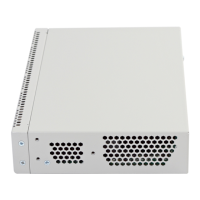8.4.2 Sub-interface configuration example
Objective:
Configure subnet 192.168.3.1/24 in VLAN: 828 on the physical interface gigabitethernet 1/0/1.
Solution:
Create sub-interface for VLAN: 828
esr(config)# interface gigabitethernet 1/0/1.828
Configure IP address from necessary subnet.
esr(config)# interface gigabitethernet 1/0/1.828
esr(config-subif)# ip address 192.168.3.1/24
esr(config-subif)# exit
8.5 Q-in-Q termination configuration
Q-in-Q is a technology of packet transmission with two 802.1q tags. The technology is used for extending
quantity of VLANs in data networks. 802.1q header, which is closer to payload, is an Inner Tag. also known as
C-VLAN (Customer VLAN). 802.1q header, which is comes before C-VLAN, is an Outer Tag also known as S-
VLAN (Service VLAN). Using of double tags in Ethernet frames is describing by 802.1ad protocol.
8.5.1 Configuration algorithm
Step Description Command Keys
1 Create a sub-interface of a physical
interface (possible if the physical
interface is in routeport or hybrid
mode).
esr(config)# interface
gigabitethernet <PORT>.<S-VLAN>
or
interface tengigabitethernet
<PORT>.<S-VLAN>
or
interface port-channel <CH>.<S-
VLAN>
<PORT> – physical interface
number.
<CH> – aggregated interface
number.
<S-VLAN> – identifier of
created S-VLAN.
If a physical interface is
included in bridge-group, it will
be impossible to create sub-
interface.
In addition to assigning an IP address, you must either disable the firewall or configure the
corresponding security zone on the sub interface.

